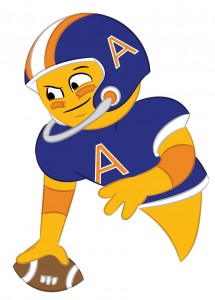4 Tips to Becoming a Better Offensive Lineman
 If you’re an offensive lineman or if you dream to become one, “BIG” is your lifestyle; and if it’s not, it should be. Offensive linemen are normally the largest bodies on the field at any given point. It’s their job to protect the team’s most important offensive weapon, the quarterback, and to create holes to be exposed through the running game. The sizes of offensive linemen vary, but it is normal for offensive tackles to be the tallest and thickest; guards are slightly shorter and stockier, and centers are usually the shortest and stockiest of the group.
If you’re an offensive lineman or if you dream to become one, “BIG” is your lifestyle; and if it’s not, it should be. Offensive linemen are normally the largest bodies on the field at any given point. It’s their job to protect the team’s most important offensive weapon, the quarterback, and to create holes to be exposed through the running game. The sizes of offensive linemen vary, but it is normal for offensive tackles to be the tallest and thickest; guards are slightly shorter and stockier, and centers are usually the shortest and stockiest of the group.
Understand Where You Fit
Different offenses recruit different-sized linemen depending on the type of offense they’re accustomed to running. As a potential college football prospect, it’s important that you understand and look into offensive schemes that recruit linemen similar to your body style and type. This can be accomplished by watching games on particular teams and spending time looking over the rosters for schools that pique your interest.
Befriend the Weight Room
Maintaining size isn’t always easy; it takes dedication in eating the right food items, as well as consistent, properly balanced workouts. Offensive linemen rely on their ability to push, punch, and stun their opponents into submission. This strength comes from an explosion of the latissimus dorsi and pectoral muscles, which should be an area of focus as an up-and-coming lineman recruit. Linemen are also expected to have strong back and core muscles that are able to support the weight that their bodies must maintain. Lastly, a lineman needs to have a strong lower body. You must possess the strength to push others around, built from squats (both standard and front), lunges, power cleans, and hamstring/quadriceps exercises.
Footwork, Footwork, Footwork
Although it sounds like an oxymoron, offensive linemen need to be light on their feet. College coaches recruit linemen who are able to move around quickly and nimbly. Footwork speed can be improved by running stadiums, doing agility ladders, and dot drills. While improving your footwork, you will also want to improve your speed. Coaches don’t expect a 4.4 40-yard dash, but they do expect you to be able to pull and block up field with speed and ease. Pulling sleds and running 40s are a couple of ways to increase your speed. Practice being explosive as you get out of your stance and move up field by running 10- and 20- yard sprints as well as the three-cone drill.
Pass Blocking
Even the most effective run blockers are useless if they cannot block in passing situations. Pass blocking, like run blocking, is about leverage and balance. Many young linemen learning to pass block come out of a two or three point stance square, standing straight up, making them easy to topple. Watching film on college or professional linemen, one will notice most linemen, although somewhat square at the line of scrimmage, stagger their stance once engaged; this skill is referred to as kick stepping. Kick stepping is effective because it’s very difficult to push over an opponent over who is low and has a spread out-base.
Armstrong Atlantic State University Sports Recruiting.
Do you have questions about playing college football? Leave them in the comments section below or ask us on Facebook, Twitter, or Google+!
Find opportunities for athletic scholarships and get connected to college coaches.
